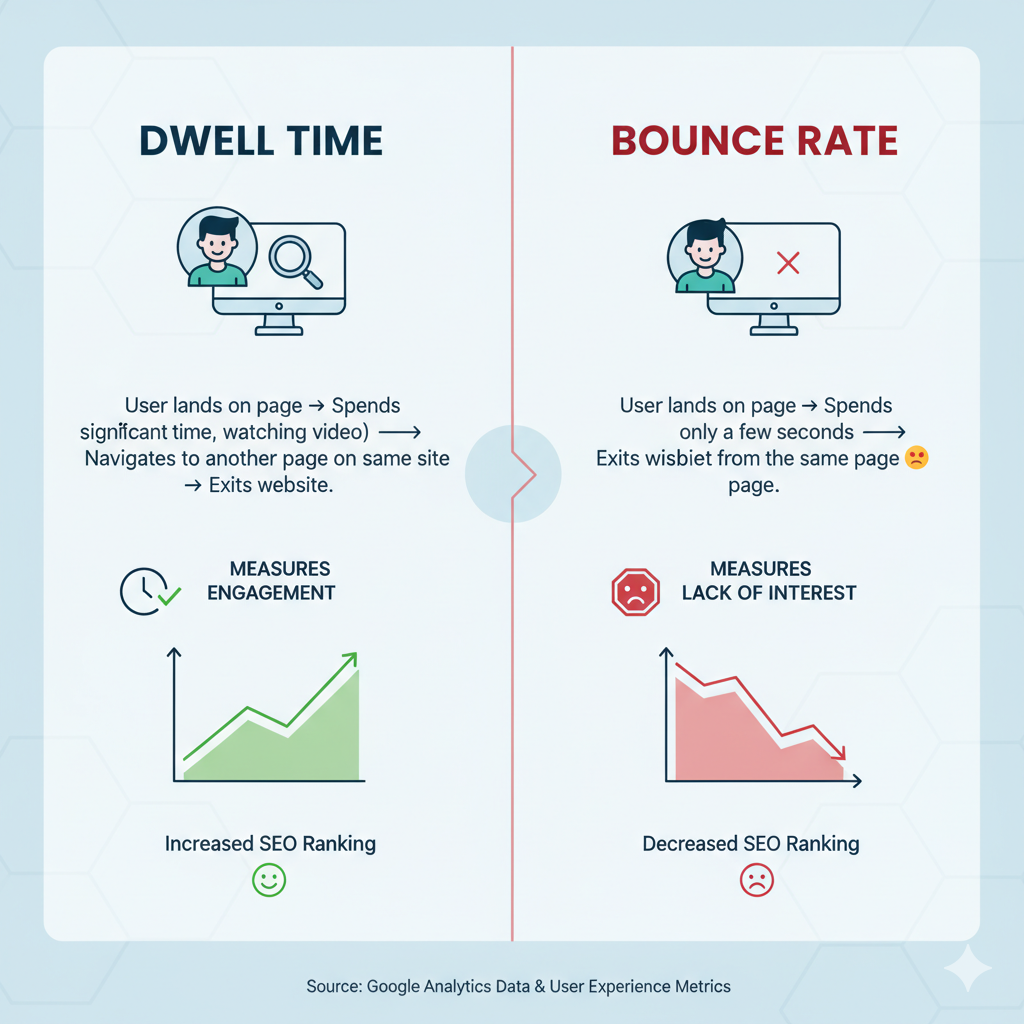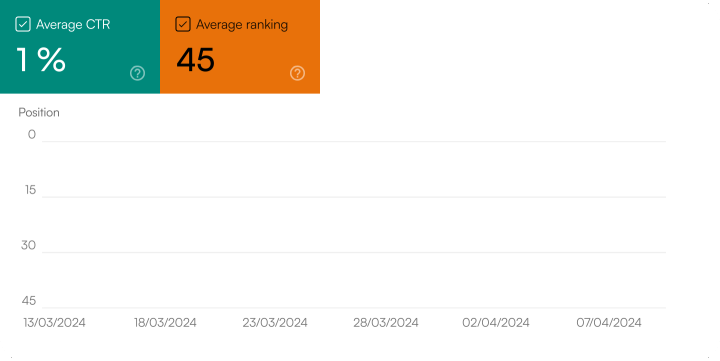
How to Increase Dwell Time on Your Website: The Ultimate Guide

Keeping visitors engaged on your website has never been more critical. While you may focus on driving traffic and improving click-through rates, there's another metric that deserves equal attention: dwell time.

How to Increase Dwell Time on Your Website: The Ultimate Guide
Meta Description: Learn how to increase dwell time on your website with these expert strategies. Boost engagement, improve SEO, and keep visitors hooked. Get actionable tips now!
Introduction
In the competitive landscape of digital marketing, keeping visitors engaged on your website has never been more critical. While you may focus on driving traffic and improving click-through rates, there's another metric that deserves equal attention: dwell time.
What is Dwell Time?
Dwell time refers to the amount of time a user spends on your webpage after clicking through from a search engine result page (SERP) before returning to the search results. It's a powerful indicator of content quality and user satisfaction. When someone lands on your page and stays to read, watch, or interact with your content, it signals to search engines that your page provides value.
Why Dwell Time Matters for Your Website's Success
Dwell time serves as a quality signal to search engines like Google. While Google hasn't explicitly confirmed dwell time as a direct ranking factor, the correlation between longer dwell times and higher rankings is well-documented across the SEO community. When users spend more time on your site, it indicates that your content is relevant, engaging, and valuable—exactly what search engines want to promote.
Beyond SEO benefits, improving dwell time translates to real business outcomes. Users who spend more time on your site are more likely to convert, whether that means making a purchase, signing up for a newsletter, or requesting a quote. Higher engagement also builds brand trust and authority in your niche.
The Difference Between Dwell Time, Session Duration, and Bounce Rate
Understanding these metrics helps you interpret your analytics correctly:
Dwell Time measures the time between clicking a search result and returning to the SERP. It's specifically tied to search engine behavior.
Session Duration tracks the total time a user spends on your website during a single visit, regardless of how they arrived. This can include multiple page views.
Bounce Rate indicates the percentage of visitors who leave your site after viewing only one page. A high bounce rate doesn't always mean poor dwell time—someone might have found exactly what they needed quickly.
While these metrics overlap, dwell time specifically reflects how well your content satisfies search intent. Now, let's explore proven strategies to boost it.
Foundational Strategies to Boost Dwell Time
Create High-Quality, Engaging Content
Content quality remains the cornerstone of user engagement. Superficial, thin content won't keep visitors on your page, no matter how well-optimized your technical SEO might be.
Deep Dives Into Topics: Instead of skimming the surface, provide comprehensive coverage of your subject matter. If someone searches for "how to increase dwell time," they want detailed, actionable information—not a 300-word overview that could be found anywhere. Aim to become the definitive resource on your topic.
Original Research and Unique Perspectives: Stand out from competitors by offering something they can't find elsewhere. Conduct original surveys, compile industry data, or share unique insights from your experience. When you provide exclusive value, users have reason to stay and absorb your content.
Solve User Problems Effectively: Every search query represents a question or problem. Your content should provide clear, practical solutions. Address common pain points, anticipate follow-up questions, and guide users toward outcomes. When people feel they're making progress on their goals, they naturally spend more time engaging with your material.
Optimize for Readability and User Experience (UX)
Even the most insightful content will fail if it's difficult to read. User experience directly impacts how long visitors choose to stay on your page.
Clear Headings and Subheadings: Break your content into scannable sections with descriptive headings. Users often skim before committing to read in depth. Well-structured headings help them quickly assess whether your content addresses their needs.
Short Paragraphs and Sentences: Online readers have limited attention spans. Keep paragraphs to three or four sentences maximum. Vary sentence length to maintain rhythm, but favor clarity over complexity. Dense blocks of text intimidate readers and increase the likelihood they'll leave.
Use Bullet Points and Numbered Lists: Lists make information digestible and memorable. They provide visual breaks in your content and allow readers to quickly extract key takeaways. When appropriate, use lists to present steps, tips, or related concepts.
Adequate White Space: Don't cram your page with text. White space gives readers' eyes room to rest and makes content feel less overwhelming. Proper spacing between elements creates a clean, professional appearance that encourages reading.
Appropriate Font Size and Contrast: Ensure your text is easily readable across all devices. Use font sizes of at least 16 pixels for body text. Maintain strong contrast between text and background—typically dark text on a light background. Poor readability forces users to strain, leading to faster exits.
Improve Website Speed and Performance
Page load time dramatically affects user engagement. Research consistently shows that even a one-second delay in page response can result in significant drops in visitor satisfaction.
Impact of Slow Loading Times: When users click through from search results, they expect instant access to information. If your page takes more than three seconds to load, many visitors will hit the back button before your content even appears. Slow sites frustrate users and signal to search engines that you're not providing a quality experience.
Tips for Optimizing Images, Code, and Server Response:
Compress images without sacrificing quality using tools like TinyPNG or built-in CMS compression. Implement lazy loading so images only load as users scroll to them. Minimize CSS and JavaScript files, removing unnecessary code. Consider using a content delivery network (CDN) to serve resources from servers closer to your users. Enable browser caching so returning visitors load your pages faster. Choose reliable hosting that can handle traffic spikes without slowdowns.
Advanced Techniques for Maximizing User Engagement
Leverage Multimedia (Images, Videos, Infographics)
Text alone rarely maximizes engagement. Visual content captures attention, clarifies complex concepts, and provides variety that keeps users interested.
How Visuals Keep Users Engaged: The human brain processes images 60,000 times faster than text. Strategic use of visuals breaks up content, illustrates points that would require lengthy explanations, and appeals to visual learners. Videos are particularly powerful—including a video on a page can increase dwell time by several minutes.
Best Practices for Embedding and Optimizing: Place images and videos where they add value, not just decoration. Ensure videos don't autoplay with sound, which annoys users. Optimize video files for web delivery or embed from platforms like YouTube for faster loading. Always include alt text for images to improve accessibility and SEO. Consider creating custom infographics that present data or processes in visually compelling ways.
Implement Internal Linking Strategies
Strategic internal links serve dual purposes: they help search engines understand your site structure and they guide users to additional relevant content, extending their time on site.
Guiding Users to Relevant Content: Think about the natural progression of user interests. Someone reading about increasing dwell time might also benefit from articles on content creation or website optimization. Place internal links contextually within your content where they genuinely add value, not just in a "related posts" section at the end.
Anchor Text Optimization: Use descriptive anchor text that tells users exactly what they'll find when they click. Instead of "click here" or "read more," use phrases like "learn how to optimize your website speed" that incorporate relevant keywords while providing clarity.
Use Clear Calls-to-Action (CTAs)
Effective CTAs don't just drive conversions—they also increase engagement by giving users a clear next step.
Encouraging Further Interaction: Place CTAs strategically throughout your content, not just at the end. These might include invitations to download resources, watch related videos, subscribe to newsletters, or explore product features. Each CTA represents an opportunity for users to deepen their engagement with your site.
Examples of Effective CTAs: "Download our free dwell time optimization checklist," "Watch this 2-minute tutorial on improving page speed," "Calculate your website's engagement score." Effective CTAs are specific, action-oriented, and communicate clear value.
Design an Intuitive and Easy-to-Navigate Website
If users can't find what they need, they'll leave—regardless of content quality.
Logical Menus: Organize your navigation based on user needs, not your internal company structure. Limit top-level menu items to five to seven categories. Use clear, concise labels that communicate exactly what users will find.
Search Functionality: For content-rich sites, robust search functionality is essential. Implement autocomplete suggestions, filter options, and ensure your search returns relevant results quickly.
Responsive Design for Mobile: With mobile traffic exceeding desktop for most sites, mobile optimization isn't optional. Your site must load quickly, display properly, and be fully functional on smartphones and tablets. Test your site regularly on various devices and screen sizes.
Encourage Comments and Community Interaction
User-generated content extends dwell time by giving visitors reasons to return and engage beyond your original content.
Benefits of User-Generated Content: Active comment sections signal to new visitors that your content sparks meaningful discussion. Reading comments and replies can add several minutes to dwell time. Community interaction also provides valuable feedback and content ideas.
Moderation Tips: Foster constructive discussion by moderating comments promptly. Remove spam and inflammatory content while encouraging thoughtful contributions. Consider highlighting particularly insightful comments. Respond to comments yourself when appropriate to show you're engaged with your audience.
Storytelling and Emotional Connection
Facts inform, but stories captivate. Incorporating narrative elements into your content creates emotional investment that keeps readers engaged.
How Narratives Keep Readers Captivated: Stories activate multiple areas of the brain, making content more memorable and engaging. Begin articles with relatable scenarios or customer success stories. Use case studies that demonstrate concepts in action. Share your own experiences and lessons learned. When readers connect emotionally with your content, they're far more likely to read to the end and explore further.
The Role of Analytics and Continuous Improvement
Track Dwell Time in Google Analytics
You can't improve what you don't measure. While Google Analytics doesn't show dwell time specifically, you can use related metrics to understand engagement.
How to Find and Interpret Data: Look at Average Session Duration and Time on Page under Behavior reports. Analyze these metrics alongside Bounce Rate and Pages per Session for a complete picture. Examine user flow reports to see how visitors navigate through your site.
Identifying Underperforming Pages: Sort pages by average time on page to identify which content isn't holding attention. Look for pages with high traffic but low engagement—these represent optimization opportunities. Consider which pages users exit from most frequently.
A/B Testing for Enhanced Engagement
Data-driven optimization removes guesswork from improving dwell time.
Testing Headlines, Layouts, and CTAs: Test different headline formulations to see which generate longer page views. Experiment with content layouts—some audiences prefer traditional paragraph structures while others respond better to mixed media formats. Try various CTA placements and copy to find what drives deeper engagement. Run one test at a time to isolate variables and ensure accurate results.
Gather User Feedback
Direct user insights complement quantitative analytics data.
Surveys, Heatmaps, Session Recordings: Brief on-page surveys can reveal why users came to your page and whether they found what they needed. Heatmap tools show where users click, how far they scroll, and which elements attract attention. Session recordings let you watch how real users interact with your pages, revealing friction points that might not be obvious from analytics alone.
Can a Good CTR Bot Influence Dwell Time?
As website owners seek every possible advantage, some may wonder whether automated tools can artificially boost engagement metrics.
Understanding CTR Bots and Their Intended Purpose
CTR bots are software programs designed to simulate human clicks on search results or advertisements. Their intended purpose is to inflate click-through rates artificially, creating the appearance of high interest in particular content or ads.
The Dangers and Limited Effectiveness for Dwell Time
While a CTR bot might artificially increase click-through rate, it cannot authentically increase dwell time, which measures real human engagement. Bots cannot genuinely read your content, watch your videos, or interact with your site in meaningful ways. They might load a page, but they cannot provide the engagement signals that indicate quality to search engines.
Google's algorithms have grown increasingly sophisticated at detecting unnatural behavior patterns. Artificial traffic from bots exhibits telltale characteristics: suspiciously uniform visit durations, unusual geographic patterns, lack of secondary interactions, and absence of natural user behavior like scrolling or clicking. When detected, manipulative tactics can result in penalties that harm your rankings far more than any temporary boost could help.
The fundamental problem is that bots cannot replicate genuine human engagement. Real users scroll through content, pause to absorb information, click on internal links, interact with multimedia, and sometimes convert. Bots lack this natural variation and depth of interaction.
Why Focusing on Real User Experience is Always Superior
Sustainable SEO success comes from genuinely satisfying user intent, not gaming metrics. When you focus on creating valuable content and excellent user experiences, you build long-term authority in your niche. Real engagement translates to actual business benefits: increased conversions, returning visitors, social shares, and backlinks from satisfied users.
Search engines continuously refine their ability to distinguish genuine engagement from artificial manipulation. Techniques that might provide short-term metric boosts inevitably become liabilities as detection improves. The websites that thrive long-term are those that prioritize authentic value creation.
Conclusion
Increasing dwell time on your website requires a user-centric approach that prioritizes genuine value over quick tricks. By creating high-quality content, optimizing the user experience, leveraging multimedia effectively, and continuously refining your approach based on data, you can build a website that naturally keeps visitors engaged.
Remember that dwell time isn't just an SEO metric—it's a reflection of how well you're serving your audience. When you solve problems, answer questions comprehensively, and make information easy to consume, longer dwell times follow naturally. Focus on understanding your users' needs, delivering exceptional experiences, and providing content worth spending time with.
The strategies outlined in this guide work together synergistically. Implement them systematically, measure results, and refine continuously. Your efforts to increase dwell time will simultaneously improve other crucial metrics like conversions, return visitor rates, and ultimately, your bottom line.
Start by auditing your current top pages, identifying engagement weaknesses, and implementing the foundational strategies first. As you build on these basics with advanced techniques, you'll create a website that both users and search engines reward with attention and trust.






